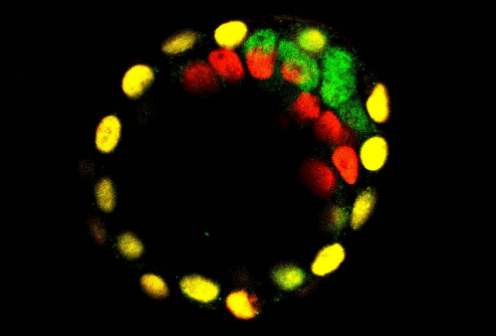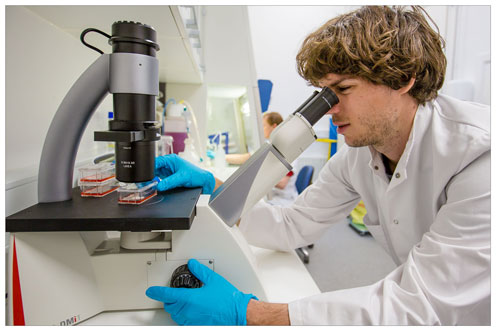The earliest stages of life might be simpler than we thought
In the very earliest stages of life, mammalian cells multiply and form the embryo. New research from the University of Copenhagen suggests that this process might be much simpler than we thought. The development of the embryo can be cut down to the cell’s ability to count their neighbouring cells.

4.5 days after fertilization the early mammalian embryo consists of approximately 100 cells. At this stage the cells form a structure consisting of a fluid-filled cavity and three different cell types. The yellow cells develop into the placenta, the red cells become the yolk sac and the green cells develop into the embryo proper.
One of the things that make human beings and other mammals unique in the animal kingdom is our cells’ ability to remember how to make an embryo. Development is the process by which a single cell, a fertilised egg, makes a complex body with head, tail, arms and legs. Mammalian cells can begin this process without any apparent external or additional information to tell them which side is up and down. More remarkable, even after they have made choices and developed into specialized cell types, individual mammalian cells can go back and do it again or twin, effectively starting from scratch. The big question is: How does the cell know how to do this? Researchers from the Faculty of Health and Medical Sciences and the Niels Bohr Institute at the University of Copenhagen have published a study that suggests that life at embryo stage is simpler than we thought.
“Cells are much smarter than we give them credit for. We have shown that they can build an embryo just by making four simple decisions. The most prominent of these is counting their neighbours. It almost sounds too simple to be true, but by counting their neighbours, the cells can determine whether they are placed on the outside or on the inside of the cell group. When they have made their decision, they adjust their properties, start to specialize and begin to form an embryo,” says Professor Josh Brickman from The Danish Stem Cell Center (DanStem).
The researchers used a computer simulation to make a cell-behaviour model. The idea was to find the minimal requirements for the cells to develop into an embryo, and the researchers cut it down to four rules or decisions for the cells to make based on their neighbours: adopt polarity, make lineage choices, alter its adhesion or die. They then tested the model in mice cells. The results showed that the model predicted the behaviour of the cells perfectly.
Development and evolution
The question of how the cells are able to form a pattern and develop into an embryo has been a source of debate for years. One theory was that there had to be some unfound information from the mother placed on one side of the egg, which provided the cells with an essential map. Another theory was that master control genes vary at random until they find the right combination. What the researchers have essentially done is say that these explanations are unnecessary and that the very earliest stages of mammalian life are much simpler than we thought.
The results also offer a further understanding of how evolution is even possible. In order for evolution to work, the genes that direct development have to change at a quite significant range. However, it is hard to conceive how the master control genes can change that drastically without messing the whole thing up.

Silas Boye Nissen, PhD.-student at the Niels Bohr Institute.
“We have shown that by following the four simple rules, the cells will develop themselves. They only need a little bit of information from the genome, which allows evolution to play with the genes as much as it likes. Basically, it provides the robustness to ensure that development will always work, but then it gives evolution the room to play with the genome. This gives rise to the diversity of the mammalian species,” says PhD student from the Niels Bohr Institute Silas Boye Nissen.
The article ‘Four simple rules that are sufficient to generate the mammalian blastocyst’ is a product of StemPhys, a new multi-disciplinary initiative between SUND and the Niels Bohr Institute funded by the Danish National Research Foundation. The work is published in the journal PLoS Biology.
Contact:
Associate Professor Ala Trusina
E-mail: trusina@nbi.ku.dk
Telefon 212 886 47
Contact
Associate Professor Ala Trusina
E-mail: trusina@nbi.ku.dk
Telefon 212 886 47
